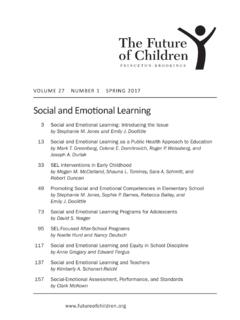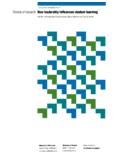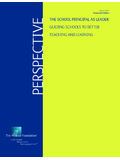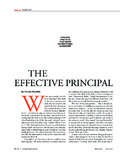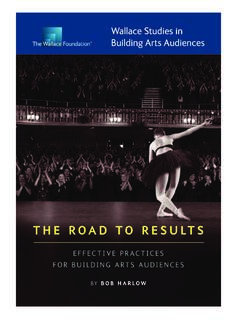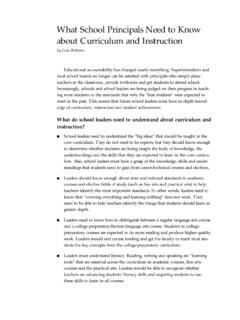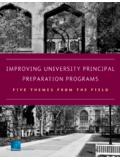Transcription of How Principals Affect Students and Schools
1 R E S E A R C H R E P O R T How Principals Affect Students and Schools A Systematic Synthesis of Two Decades of Research Jason A. Grissom Anna J. Egalite Constance A. Lindsay V A N D E R B I L T U N I V E R S I T Y N O R T H C A R O L I N A S T A T E U N I V E R S I T Y O F N O R T H U N I V E R S I T Y C A R O L I N A A T C H A PE L H I L L February 2021 Commissioned by The Wallace Foundation is a philanthropy working nationally to answer important questions that, if solved, could help strengthen practices and policies within a field. Our mission is to enhance the human condition, with a particular focus on children s learning and development, through the preparation of teachers and leaders; through cycles of research, implementation, and refinement; through service to families, Schools , and communities; and through external engagement with professionals, leaders, and policymakers. The College of Education is a voice of innovation for learning across the lifespan.
2 We prepare professionals who educate and lead. Our inquiry and practice reflect integrity, a commitment to social justice and the value of diversity in a global community. The School of Education at the University of North Carolina at Chapel Hill is committed to realizing the transformative power of education, and in turn is redefining what it means to educate. Education has the power to break down barriers, lift up individuals, and empower communities to rise and thrive. To that end, we inspire educators to lead; to think creatively, act with passion, and strive toward equity for all. The nonprofit Urban Institute is a leading research organization dedicated to developing evidence-based insights that improve people s lives and strengthen communities. For 50 years, Urban has been the trusted source for rigorous analysis of complex social and economic issues; strategic advice to policymakers, philanthropists, and practitioners; and new, promising ideas that expand opportunities for all.
3 Our work inspires effective decisions that advance fairness and enhance the well-being of people and places. Suggested Citation Grissom, Jason A., Anna J. Egalite, and Constance A. Lindsay. 2021. How Principals Affect Students and Schools : A Systematic Synthesis of Two Decades of Research. New York: The Wallace Foundation. Available at Copyright February 2021. Permission is granted for reproduction of this file, with attribution to Vanderbilt University. Cover photo by monkey business Images/Shutterstock. Contents Acknowledgments vi Glossary vii Foreword ix Executive Summary xi 1. Introduction 1 2. The Policy Context of School Leadership since 2000 6 3. Changes in the Principal Workforce from 1988 to 2016 11 4. Synthesis Methodology 29 5. How Large Are Principal Effects? 34 6. How Principals Attributes Matter: Evidence on Race, Ethnicity, Gender, Experience, and Other Characteristics 44 7. Principals Skills and Behaviors That Support Learning 54 8.
4 The State of the Evidence on School Principals 81 9. Implications and Conclusions 91 Appendix A. Details on Search Strategy 95 Notes 100 References 102 About the Authors 117 vi A C K N O W L E D G M E N T S Acknowledgments We gratefully acknowledge the contributions of the many individuals who made this report possible. Josh Bleiberg was invaluable in setting up our coding and reference management infrastructure, implementing the literature search, and assisting with study coding. Lara Condon, Daniela Barriga, and Elizabeth Uzzel also provided excellent coding and research assistance. Shirley Xu assisted with compiling the reference list. Alphonse Simon and Grace Luetmer at the Urban Institute assisted with analysis of national datasets. We are also grateful to David Golann from Vanderbilt s Peabody Library, whose expertise informed our database search protocol. At the Urban Institute, we thank Wesley Jenkins, Brittney Spinner, and John Wehmann for their graphic design work, David Hinson for expertly editing and producing the report, and Alexandra Tilsley for planning and managing communications and outreach.
5 Our report benefited greatly from thoughtful, probing feedback from five external reviewers: Elaine Allensworth, Sonya Douglass Horsford, David Liebowitz, Sara Morrison, and Jessica Rigby. Brendan Bartanen and Matthew Kraft also provided helpful feedback and advice on specific components of the report. We also thank the staff of The Wallace Foundation for their thoughtful feedback and expert guidance throughout this process. We especially appreciated the input of Elizabeth Ty Wilde, Pam Mendels, Lucas Held, and Andy Cole. Lastly, an unusual but rewarding aspect of our effort on this knowledge synthesis was that we worked alongside two other teams writing their own syntheses on related topics with whom we frequently communicated and conferred: Ellen Goldring, Mollie Rubin, Mariesa Herrmann, Linda Darling-Hammond, Marjorie Wechsler, and Stephanie Levin. We appreciated their insights throughout the research process and their feedback on an earlier draft.
6 G L O S S A R Y v i i Glossary education specialist degree. An advanced professional degree designed to provide focused expertise in education leadership or another area beyond the master s level. exclusionary discipline. School disciplinary actions that remove Students from their usual educational setting. These actions include in-school suspension, out-of-school suspension, and expulsion. grey literature. Research produced by organizations that is published outside traditional commercial or academic outlets. Grey literature includes reports, working papers, and technical documents produced by governments, research firms, and other entities that are not published in academic journals though they are often still subject to some form of peer review. in-school suspension. A form of student discipline that temporarily keeps Students in school and engaged in schoolwork but isolates them from other Students . longitudinal data. Data that follow the same units ( , Schools , Principals ) over multiple years.
7 Also referred to as panel data. multiple-measure educator evaluation. A system for rating the performance of an educator, such as a teacher or principal, that combines more than one performance metric. These metrics most often are a rubric-based measure of practice ( , classroom observations for teachers, leadership practice ratings for Principals ) and a measure derived from the achievement of the Students the educator serves, such as a test score growth measure. out-of-school suspension. A form of student discipline that temporarily removes Students from school and school activities. panel data methods. A category of statistical tools that rely on data on the same units repeated over time. phenomenology. A discipline in philosophy concerned with studying how phenomena are consciously experienced from the first-person point of view. principal. The head or person with the most authority in a K 12 school. In this report, we distinguish Principals from other school leaders, such as assistant Principals .
8 Professional Standards for Educational Leaders (PSEL). A set of 10 standards that were released in 2015 by the National Policy Board for Educational Administration. The earlier version of the PSEL were the Interstate School Leaders Licensure Consortium (ISLLC) Standards. Through professional associations, supporting institutions, and policy, the standards are expected to influence leadership v i i i G L O S S A R Y practices and, ultimately, leadership outcomes. Member organizations include the American Association of Colleges for Teacher Education, American Association of School Administrators, Council for the Accreditation of Educator Preparation, Council of Chief State School Officers, National Association of Elementary School Principals , National Association of Secondary School Principals , National Council of Professors of Educational Administration, National School Boards Association, and University Council for Educational Administration.
9 Quasi-experimental designs. A class of research approaches that aim to infer causal relationships in the absence of random assignment by comparing units that receive a treatment with a suitable comparison group, with some strategy for accounting for the process by which units are assigned to a treatment or control group. standard deviation. A way to measure the width of a distribution. Larger values mean that there is more variation in the values a variable takes on. value-added measures. Metrics derived from statistical models of student test score growth over time that aim to capture the contribution of a schooling input, such as teachers or Principals . Foreword In 1999, The Wallace Foundation s board of directors decided to make what it called a big bet on school leadership. At that time, the principalship was not widely seen as crucial in school improvement. The board found this odd. Leadership is critical in nearly every other sector of society from business to the military, from religion to higher education.
10 They reasoned education leadership might not be getting the attention it deserved. Since then, leadership has received more attention as an essential ingredient in efforts to improve Schools and student learning. A review the foundation commissioned about what was known about the impact of leadership on student learning contributed to this understanding. Published in 2004, How Leadership Influences Student Learning found that leadership was second only to teaching among in-school factors that Affect student learning with investments in strengthening it likely to be cost-effective. This report (downloaded more than 800,000 times from the Wallace website) helped pave the way for a growing consensus that improving the training and support of Principals is worthwhile. Since then, what we know about school leadership has continued to evolve, with more experience, more research, and new research methods. For that reason, in 2019, Wallace commissioned a new review of the evidence base about the link between leadership and learning.
